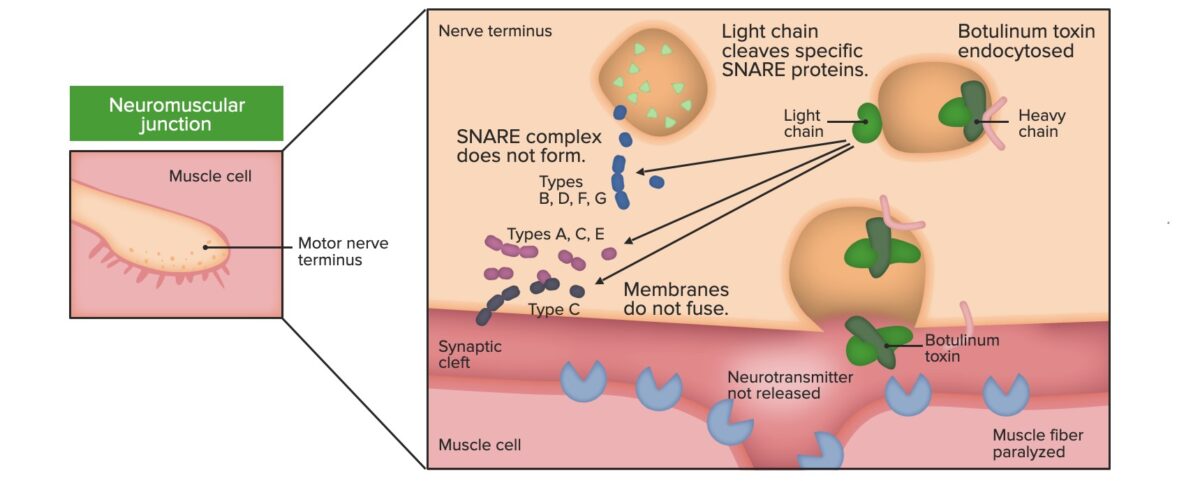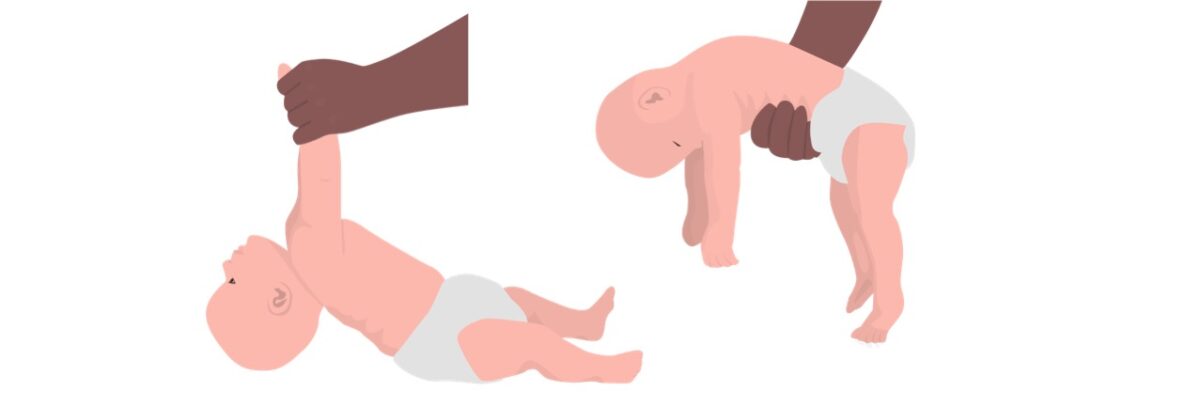Botulism is a rare, neuroparalytic syndrome caused by Clostridium botulinum Clostridium botulinum A species of anaerobic, gram-positive, rod-shaped bacteria in the family clostridiaceae that produces proteins with characteristic neurotoxicity. It is the etiologic agent of botulism in humans, wild fowl, horses; and cattle. Seven subtypes (sometimes called antigenic types, or strains) exist, each producing a different botulinum toxin (botulinum toxins). The organism and its spores are widely distributed in nature. Clostridia ( C. botulinum C. botulinum A species of anaerobic, gram-positive, rod-shaped bacteria in the family clostridiaceae that produces proteins with characteristic neurotoxicity. It is the etiologic agent of botulism in humans, wild fowl, horses; and cattle. Seven subtypes (sometimes called antigenic types, or strains) exist, each producing a different botulinum toxin (botulinum toxins). The organism and its spores are widely distributed in nature. Clostridia). A fatal neurotoxin (botulinum toxin) is released causing varying degrees of muscle paralysis and distinct clinical syndromes. The most common types of botulism are foodborne and infant. Botulism presents with blurred vision Blurred Vision Retinal Detachment, respiratory failure Respiratory failure Respiratory failure is a syndrome that develops when the respiratory system is unable to maintain oxygenation and/or ventilation. Respiratory failure may be acute or chronic and is classified as hypoxemic, hypercapnic, or a combination of the two. Respiratory Failure, and symmetric, descending flaccid paralysis. Characterization includes intact sensorium, normal heart rate Heart rate The number of times the heart ventricles contract per unit of time, usually per minute. Cardiac Physiology and blood pressure, absence of fever Fever Fever is defined as a measured body temperature of at least 38°C (100.4°F). Fever is caused by circulating endogenous and/or exogenous pyrogens that increase levels of prostaglandin E2 in the hypothalamus. Fever is commonly associated with chills, rigors, sweating, and flushing of the skin. Fever, and absence of sensory Sensory Neurons which conduct nerve impulses to the central nervous system. Nervous System: Histology deficits. Diagnosis is made on clinical grounds and can be confirmed by the isolation of bacteria Bacteria Bacteria are prokaryotic single-celled microorganisms that are metabolically active and divide by binary fission. Some of these organisms play a significant role in the pathogenesis of diseases. Bacteriology or toxins from stool, wound specimens, or food sources. The approach to managing a case of botulism should include prompt management of respiratory failure Respiratory failure Respiratory failure is a syndrome that develops when the respiratory system is unable to maintain oxygenation and/or ventilation. Respiratory failure may be acute or chronic and is classified as hypoxemic, hypercapnic, or a combination of the two. Respiratory Failure, administration of antitoxin, and supportive care for paralysis.
Last updated: May 7, 2025
Botulism is a rare, neuroparalytic syndrome caused by the bacteria Bacteria Bacteria are prokaryotic single-celled microorganisms that are metabolically active and divide by binary fission. Some of these organisms play a significant role in the pathogenesis of diseases. Bacteriology Clostridium botulinum Clostridium botulinum A species of anaerobic, gram-positive, rod-shaped bacteria in the family clostridiaceae that produces proteins with characteristic neurotoxicity. It is the etiologic agent of botulism in humans, wild fowl, horses; and cattle. Seven subtypes (sometimes called antigenic types, or strains) exist, each producing a different botulinum toxin (botulinum toxins). The organism and its spores are widely distributed in nature. Clostridia ( C. botulinum C. botulinum A species of anaerobic, gram-positive, rod-shaped bacteria in the family clostridiaceae that produces proteins with characteristic neurotoxicity. It is the etiologic agent of botulism in humans, wild fowl, horses; and cattle. Seven subtypes (sometimes called antigenic types, or strains) exist, each producing a different botulinum toxin (botulinum toxins). The organism and its spores are widely distributed in nature. Clostridia), which releases a fatal neurotoxin (botulinum toxin), resulting in varying degrees of muscle paralysis and distinct clinical syndromes.

A photomicrograph of C. botulinum bacteria
Image: “Clostridium botulinum” by CDC. License: Public DomainThe means of exposure to the toxin will determine the type of botulism; the toxin is not absorbed through intact skin Skin The skin, also referred to as the integumentary system, is the largest organ of the body. The skin is primarily composed of the epidermis (outer layer) and dermis (deep layer). The epidermis is primarily composed of keratinocytes that undergo rapid turnover, while the dermis contains dense layers of connective tissue. Skin: Structure and Functions.
Exposure can occur through the following mechanisms:
Mechanism of pathogenesis:

Effect of botulinum toxin at the level of the NMJ: inhibition of ACh release
Image by Lecturio.The classic presentation of botulism includes symmetric cranial nerve palsies Cranial Nerve Palsies Cranial nerve palsy is a congenital or acquired dysfunction of 1 or more cranial nerves that will, in turn, lead to focal neurologic abnormalities in movement or autonomic dysfunction of its territory. Head/neck trauma, mass effect, infectious processes, and ischemia/infarction are among the many etiologies for these dysfunctions. Diagnosis is initially clinical and supported by diagnostic aids. Management includes both symptomatic measures and interventions aimed at correcting the underlying cause. Cranial Nerve Palsies and descending paralysis. The 5 key features of botulism include:
Cranial neuropathies are common in all types of botulism. The classic presentation includes the “4 Ds” (bulbar symptoms):
Botulism does present with autonomic findings:

An important presentation in infant botulism: floppy baby syndrome
Image by Lecturio.
Ptosis in a child with botulism: The patient is alert and oriented.
Image: “Botulism1and2” by Herbert L. Fred, MD and Hendrik A. van Dijk. License: CC BY 2.0A detailed clinical history and diagnosis are important in botulism, as the tests take time. If a case history is highly suggestive of botulism, treatment should not be delayed.
Antitoxin is the mainstay of botulism treatment. Two major forms are available in the United States:
Heptavalent botulinum antitoxin:
Human botulinum immunoglobulin (BIG-IV):